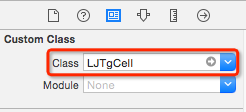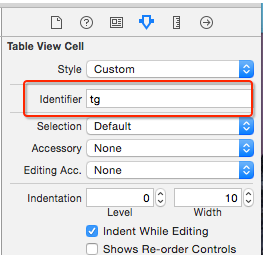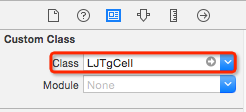自定义cell:frame,autolayout,xib,storyboard,不等高问题
利用frame和autolayout自定义cell
新建一个继承自UITableViewCell的子类,比如LJTgCell
@interface XMGTgCell : UITableViewCell
@end
在LJTgCell.m文件中
- 重写
-initWithStyle:reuseIdentifier:方法
- 在这个方法中添加所有需要显示的子控件
- 给子控件做一些初始化设置(设置字体、文字颜色等)
- 注意:如果是autolayout就要
添加子控件的完整约束
/**
* 在这个方法中添加所有的子控件
*/
- (instancetype)initWithStyle:(UITableViewCellStyle)style reuseIdentifier:(NSString *)reuseIdentifier
{
if (self = [super initWithStyle:style reuseIdentifier:reuseIdentifier]) {
// ......
}
return self;
}
- 重写
-layoutSubviews方法
- 一定要调用
[super layoutSubviews] - 在这个方法中计算和设置所有子控件的frame
/**
* 在这个方法中计算所有子控件的frame
*/
- (void)layoutSubviews
{
[super layoutSubviews]; // 这句话很容易漏写
// ......
}
在LJTgCell.h文件中提供一个模型属性,比如LJTg模型
@class LJTg;
@interface LJTgCell : UITableViewCell
/** 团购模型数据 */
@property (nonatomic, strong) LJTg *tg;
@end
在LJTgCell.m中重写模型属性的set方法
- (void)setTg:(XMGTg *)tg
{
_tg = tg;
// .......
}
在控制器中
// 有多少组
- (NSInteger)numberOfSectionsInTableView:(UITableView *)tableView
// 每组有多少行
- (NSInteger)tableView:(UITableView *)tableView
numberOfRowsInSection:(NSInteger)section
// 每行里面的内容
- (UITableViewCell *)tableView:(UITableView *)tableView
cellForRowAtIndexPath:(NSIndexPath *)indexPath
[self.tableView registerClass:[LJTgCell class] forCellReuseIdentifier:ID];
[self.tableView registerNib:[UINib nibWithNibName:
NSStringFromClass([LJTgCell class]) bundle:nil]forCellReuseIdentifier:ID];
- (UITableViewCell *)tableView:(UITableView *)tableView cellForRowAtIndexPath:(NSIndexPath *)indexPath
{
// 访问缓存池
XMGTgCell *cell = [tableView dequeueReusableCellWithIdentifier:ID];
// 设置数据(传递模型数据)
cell.tg = self.tgArray[indexPath.row];
return cell;
}
利用xib自定义cell
新建一个继承自UITableViewCell的子类,比如LJTgCell
@interface LJTgCell : UITableViewCell
@end
新建一个xib文件(文件名最好跟类名一致,比如LJTgCell.xib)




@interface LJTgCell()
@property (weak, nonatomic) IBOutlet UIImageView *iconImageView;
@property (weak, nonatomic) IBOutlet UILabel *titleLabel;
@property (weak, nonatomic) IBOutlet UILabel *priceLabel;
@property (weak, nonatomic) IBOutlet UILabel *buyCountLabel;
@end
在LJTgCell.h文件中提供一个模型属性,比如LJTg模型
@class LJTg;
@interface LJTgCell : UITableViewCell
/** 团购模型数据 */
@property (nonatomic, strong) LJTg *tg;
@end
在LJTgCell.m中重写模型属性的set方法
- (void)setTg:(Tg *)tg
{
_tg = tg;
// .......
}
在控制器中
[self.tableView registerNib:[UINibnibWithNibName:
NSStringFromClass([LJTgCell class]) bundle:nil] forCellReuseIdentifier:ID];
- (UITableViewCell *)tableView:(UITableView *)tableView
cellForRowAtIndexPath:(NSIndexPath *)indexPath
{
// 访问缓存池
LJTgCell *cell = [tableView dequeueReusableCellWithIdentifier:ID];
// 设置数据(传递模型数据)
cell.tg = self.tgs[indexPath.row];
return cell;
}
利用stroyboard自定义cell
新建一个继承自UITableViewCell的子类,比如LJTgCell
@interface LJTgCell : UITableViewCell
@end
在storyboard文件中,找到UITableView里面的cell(动态cell)



@interface LJTgCell()
@property (weak, nonatomic) IBOutlet UIImageView *iconImageView;
@property (weak, nonatomic) IBOutlet UILabel *titleLabel;
@property (weak, nonatomic) IBOutlet UILabel *priceLabel;
@property (weak, nonatomic) IBOutlet UILabel *buyCountLabel;
@end
cell不等高的方法(2种)
方法一:直接在控制器设置height的viewDidLoad方法中设置
- (void)viewDidLoad {
[super viewDidLoad];
// 告诉tableView所有cell的真实高度是自动计算(根据设置的约束来计算)
self.tableView.rowHeight = UITableViewAutomaticDimension;
// 告诉tableView所有cell的估算高度
self.tableView.estimatedRowHeight = 44;
}
方法二:给模型增加frame数据
在LJStatus.m中
@interface LJStatus : NSObject
/**** 文字\图片数据 ****/
// .....
/**** frame数据 ****/
/** 头像的frame */
@property (nonatomic, assign) CGRect iconFrame;
// .....
/** cell的高度 */
@property (nonatomic, assign) CGFloat cellH;
@end
- (CGFloat)cellH
{
if (_cellH == 0) {
// ... 计算所有子控件的frame、cell的高度
}
return _cellH;
}
在控制器中
- 实现一个返回cell高度的代理方法
- 在这个方法中返回indexPath位置对应cell的高度
/**
* 返回每一行cell的具体高度
*/
- (CGFloat)tableView:(UITableView *)tableView heightForRowAtIndexPath:(NSIndexPath *)indexPath
{
LJStatus *status = self.statuses[indexPath.row];
return status.cellH;
}
- (UITableViewCell *)tableView:(UITableView *)tableView cellForRowAtIndexPath:(NSIndexPath *)indexPath
{
static NSString *ID = @"status";
// 访问缓存池
LJStatusCell *cell = [tableView dequeueReusableCellWithIdentifier:ID];
// 设置数据(传递模型数据)
cell.status = self.statuses[indexPath.row];
return cell;
}
新建一个继承自UITableViewCell的子类,比如LJStatusCell
@interface LJStatusCell : UITableViewCell
@end
在LJStatusCell.m文件中
- 重写
-initWithStyle:reuseIdentifier:方法
- 在这个方法中添加所有可能显示的子控件
- 给子控件做一些初始化设置(设置字体、文字颜色等)
/**
* 在这个方法中添加所有的子控件
*/
- (instancetype)initWithStyle:(UITableViewCellStyle)style reuseIdentifier:(NSString *)reuseIdentifier
{
if (self = [super initWithStyle:style reuseIdentifier:reuseIdentifier]) {
// ......
}
return self;
}
在LJStatusCell.h文件中提供一个模型属性,比如LJStatus模型
@class LJStatus;
@interface LJStatusCell : UITableViewCell
/** 团购模型数据 */
@property (nonatomic, strong) LJStatus *status;
@end
在LJStatusCell.m文件中重写模型属性的set方法
- (void)setStatus:(LJStatus *)status
{
_status = status;
// .......
}
重写-layoutSubviews方法
- 一定要调用
[super layoutSubviews] - 在这个方法中
设置所有子控件的frame
/**
* 在这个方法中设置所有子控件的frame
*/
- (void)layoutSubviews
{
[super layoutSubviews];
// ......
}



























 7468
7468











 被折叠的 条评论
为什么被折叠?
被折叠的 条评论
为什么被折叠?








